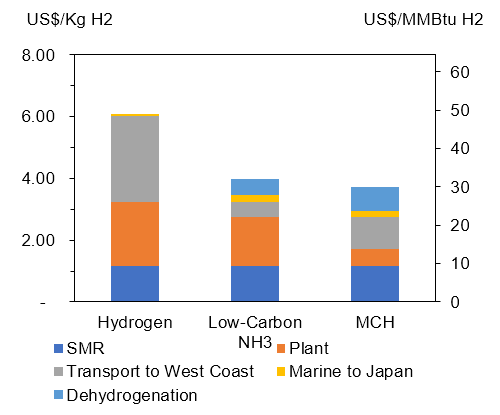Your cart is currently empty!
November 12, 2021

Hydrogen is assumed to be produced in Edmonton area utilising the Steam Methane Reformer (SMR) process with carbon sequestration.
Hydrogen case assumes gas from the SMR process is shipped via pipeline (1,150 km) to the west coast where it is liquefied and shipped via cryogenic tanker to Asia.
Low Carbon Ammonia (NH3) case assumes hydrogen is converted to NH3 in Edmonton where it is railed to the west coast and transported to Asia via LPG type rail cars/tanker. USD$3.15/Kg H2 equivalent to USD$568/t NH3 pre-dehydrogenation process.
Methylcyclohexane (MCH) case assumes hydrogen is converted to MCH in Edmonton where it is railed to the west coast and transported to Asia via crude oil type rail cars/tanker.
The ability to convert natural gas and sequester carbon near tidewater would improve overall economics.
Observations
SMR costs are directly correlated with natural gas input pricing.
- USD$6.90/Mcf input price (cost to bring Canadian gas to Asia via LNG) would result in USD$1.95/kg H2 versus USD$1.16/kg H2 @ USD$3.00/Mcf.
SMR output USD$1.16/kg H2 is equivalent to USD$9.40/MMBtu or about 4 times 2020 Henry Hub price.
- However, SoCal Gas in California has PUC approval to deliver 20% renewable natural gas (RNG) by 2030 to its franchise area. RNG has traded around USD$20-33/MMBtu over the past year (based on DC-3 RINS).
Hydrogen from electrolysis is currently 3 times more costly than SMR. Companies such as Plug Power are investigating mass modular production via high tech robotic manufacturing (~Tesla Gigafactory) to drive down costs.
- Aiming to reduce cost by 50% which could deliver the ability to compete with SMR when combined with wind/solar off peak power optimization.
See also:
Hydrogen Steam Methane Reforming (SMR) 2021
Carbon Capture and Storage for Hydrogen 2021
Low Carbon Ammonia Plant 2021
Hydrogen Pipeline 2021
Methylcyclohexane (MHC)-Toluene Hydrogenation 2021

